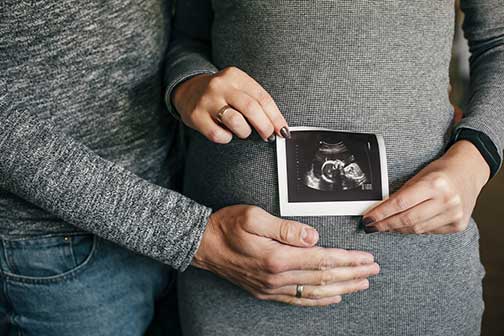The Supreme Court has scheduled arguments on December 1, 2021, in a potentially landmark case called Dobbs v. Jackson Women’s Health Organization. This case challenges the constitutionality of Mississippi’s Gestational Age Act which, with few exceptions, restricts abortions after 15 weeks of pregnancy. The lower courts which heard this case both ruled that the law violates Roe v. Wade and Planned Parenthood v. Casey.
A central question in Dobson involves the human life characteristics of an unborn child at between 15 and 20 weeks of pregnancy. Roe v. Wade was decided in 1973. Since then, there have been monumental advancements in medical science that now give us a front row seat to the pre-born children’s level of early development at this stage. Actual videos of children in the womb reveal an active baby in the womb with a marvelously intricate spine, delicate hands with all five fingers which appear to reach and scratch an itch, and facial features with a gently sloping profile, fully formed lips and eyes that open and close. The baby can be seen actually breathing and exhaling amniotic fluid as it prepares for its life outside the womb. By sixteen weeks, the child’s gender is easily detectible, and the child looks undeniably human. By nineteen weeks, the child hears noises and makes facial expressions when listening to music. https://www.ehd.org/your-life-before-birth-video/
In 1973, ultrasound was still in its infancy and now obsolete equipment could, at best, provide only murky, distorted views intra-utero. Today, many families have proudly posted on their refrigerator ultrasound photographs of their pre-born baby that provide a shining preview of coming attractions.
The Court also recently heard arguments in a case out of Kentucky called Cameron v. EMW Women’s Surgical Centerinvolving a suit on behalf of abortion providers and their patients challenging a state law banning abortions by dilation and evacuation (D&E). Unlike abortions performed by suction in the first trimester, where the fetal bones are soft enough to collapse into a large bore suction catheter, unborn children at the gestational ages of fifteen to twenty weeks cannot fit into a catheter because they are too large and their bones have calcified, making them too firm to remove from the womb by suction alone. Therefore, dilation and evacuation (D&E) procedures are required to surgically dismember the unborn child in order to extract it from the womb. This case is now awaiting decision.
The law has been slow to keep pace with the advances in medical science. Virtually all states have recognized now that human life is deserving of protection while in the womb. For example, a pregnant mother’s freedom over her body does not legitimize the use of illicit drugs resulting in the death of her baby. Likewise, some courts have even held that an unborn child is entitled to certain property rights and are entitled to the appointment of a guardian ad litem to protect these interests. Courts have awarded damages arising out of intentional injuries or crimes committed against unborn children.
Grazie Pozo Christie is a diagnostic radiologist who has submitted a “friend of the court” brief in the Dobson case. She writes: “These are the patients I encounter daily in my work as a radiologist. Clearly human, clearly alive, no longer mysteriously hidden from the eyes and knowledge of man, they ask us to consider them not disposable nonhumans but valuable members of our human family.”
The writer of Psalm 139 perhaps said it best. “You formed my inward parts and knitted me together in my mother’s womb. I praise you because I am fearfully and wonderfully made.” Our nation’s highest court will now have an opportunity to either reaffirm this truth or reject it again, as it did in 1973.
Larry L. Crain, Crain Law Group PLLC – www.crainlaw.legal














